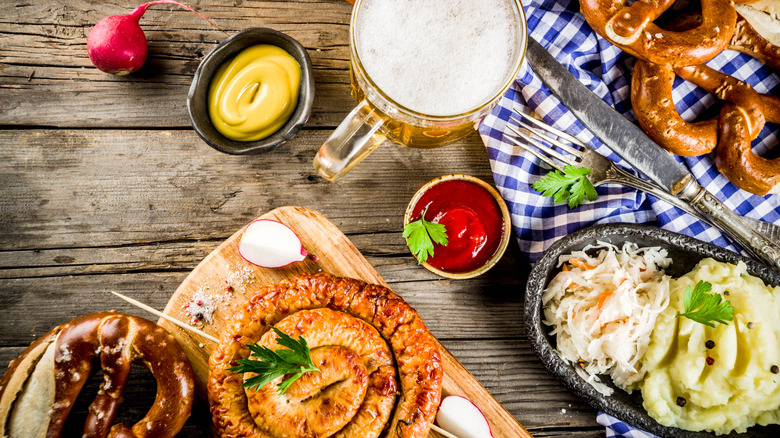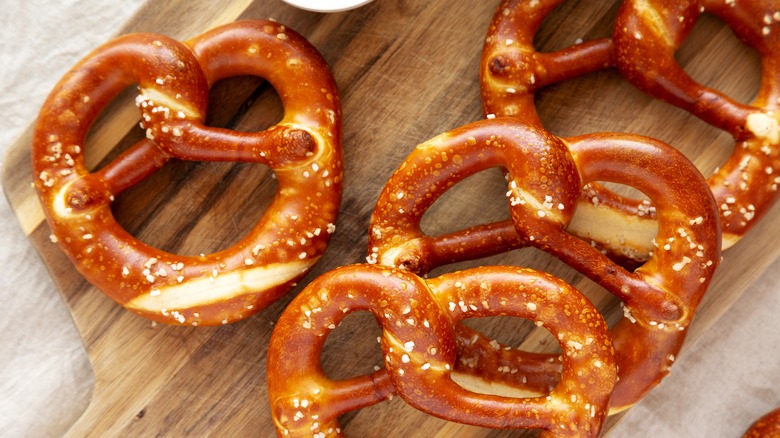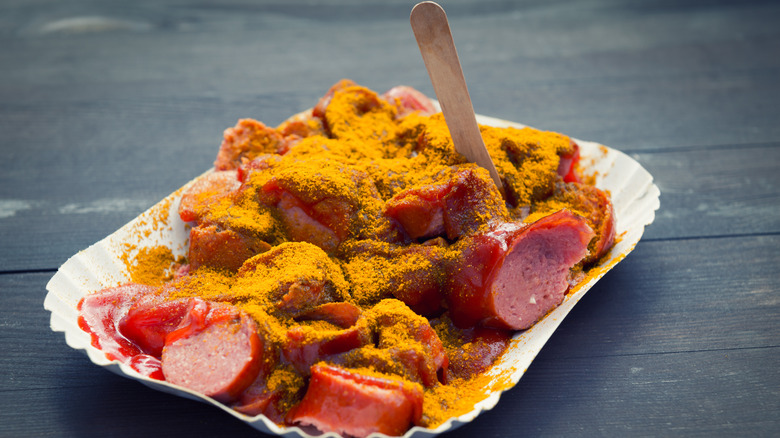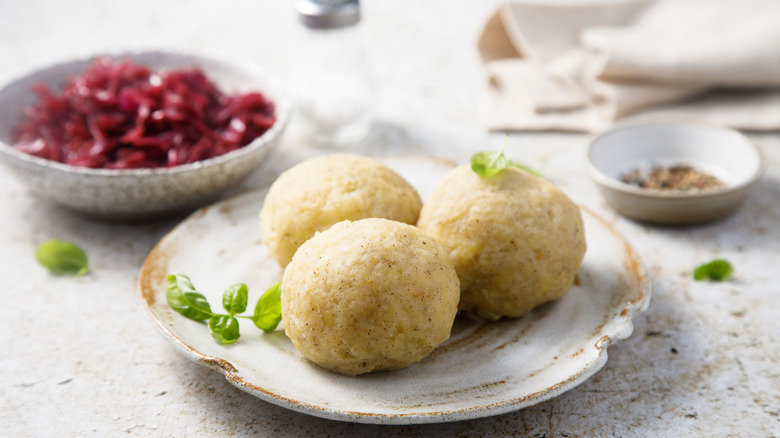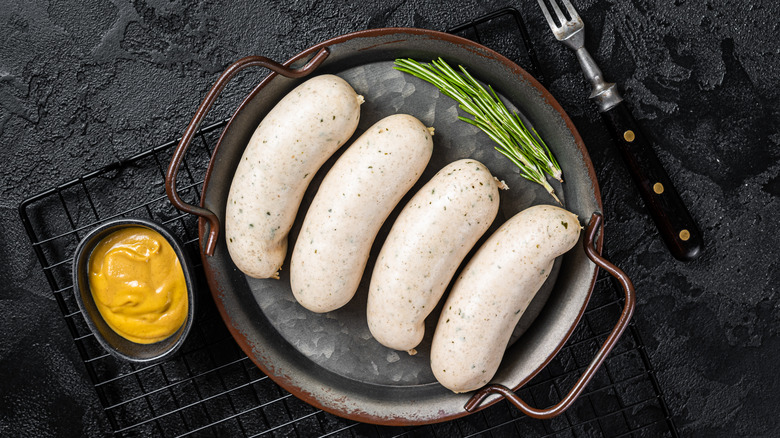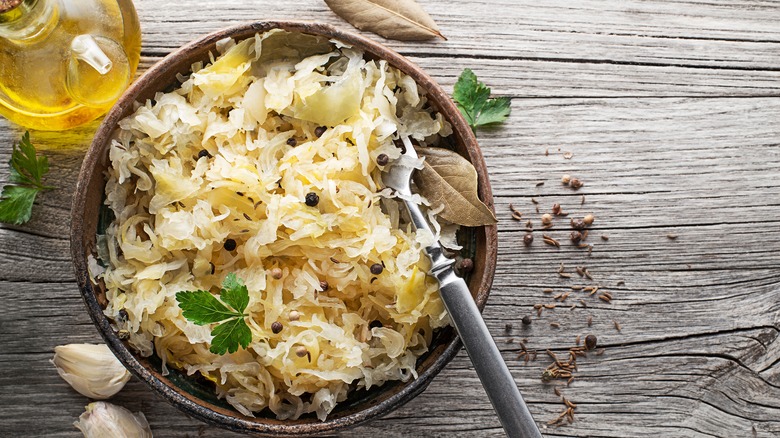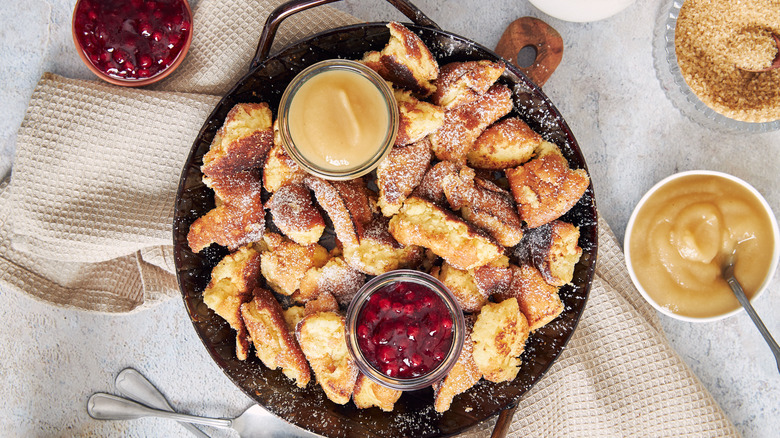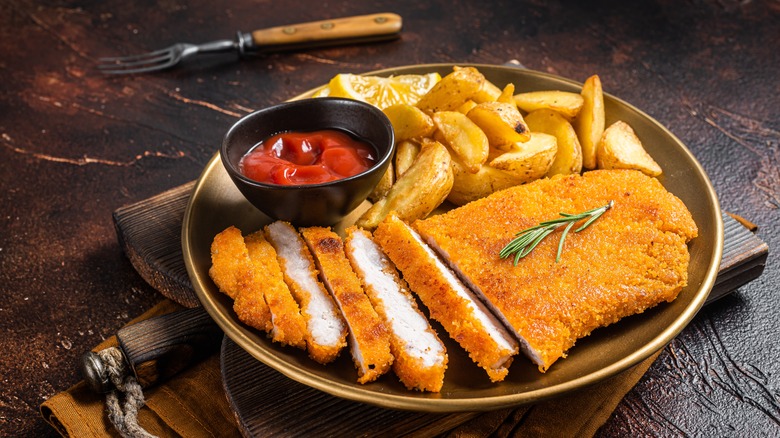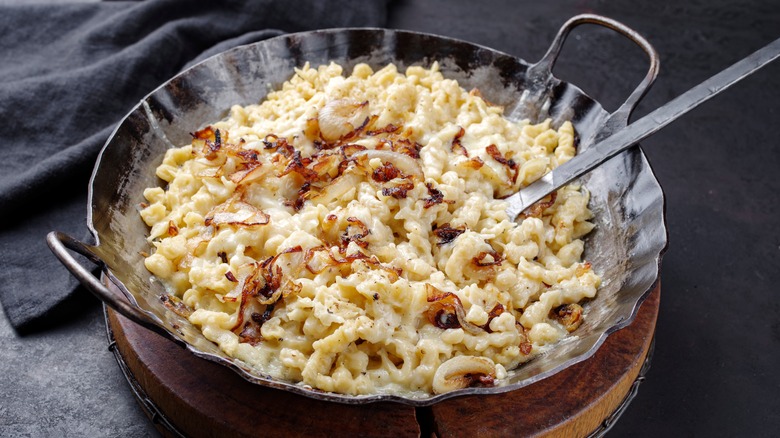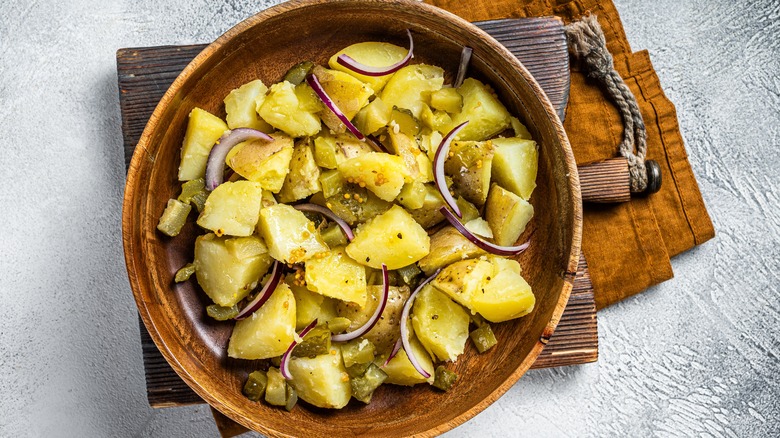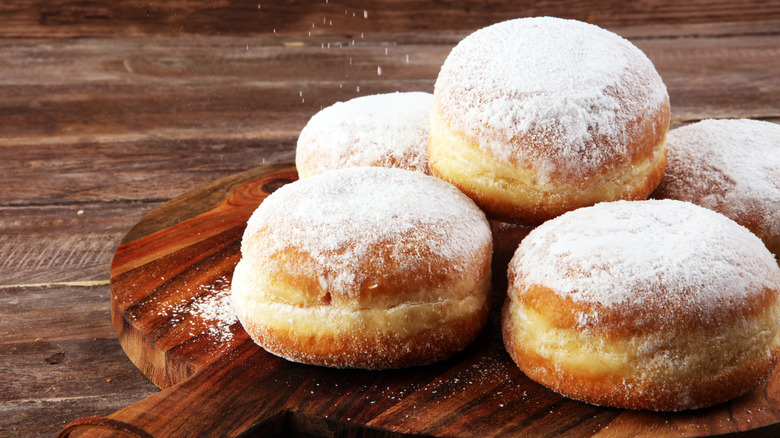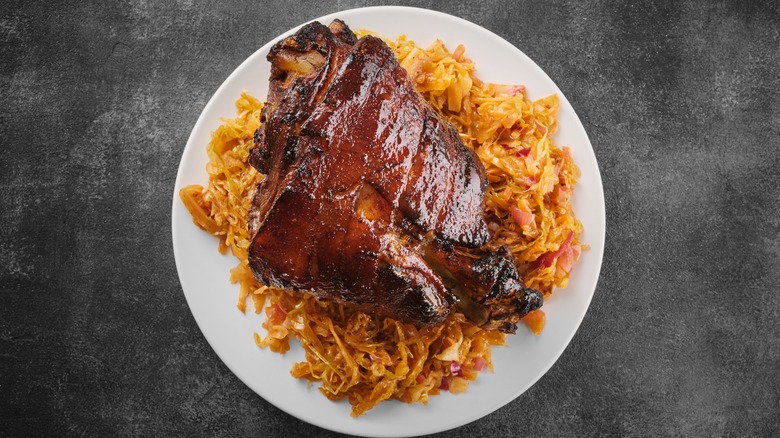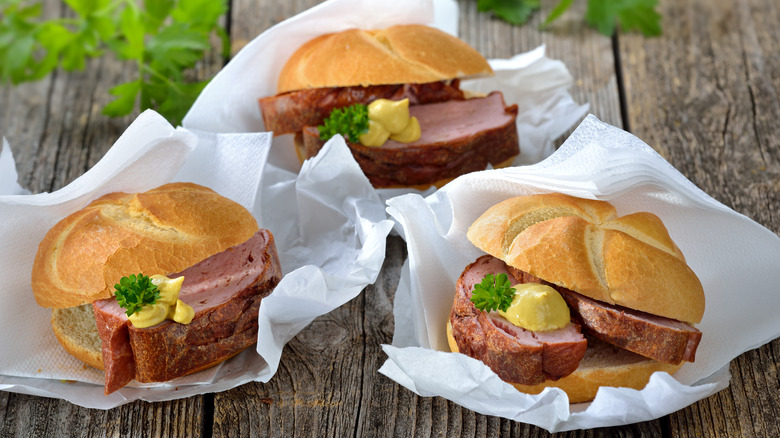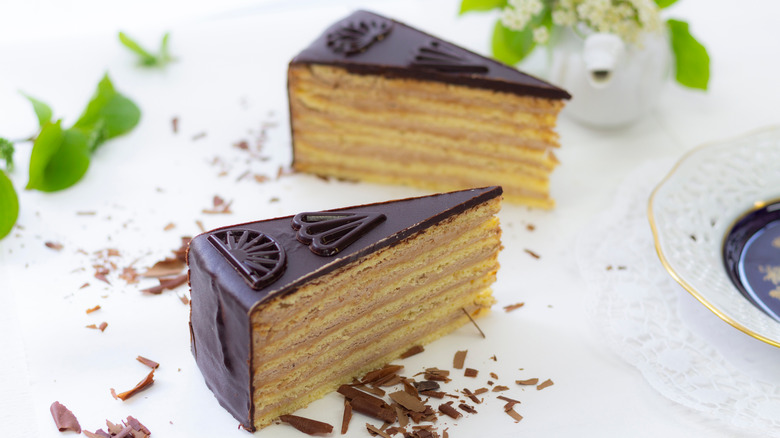14 Bavarian Foods You Have To Try In Munich
Home to winding medieval streets, enchanting neogothic architecture, and more beer halls than you can count, Munich is a bucket-list destination for beer lovers and history buffs alike. Though the city has a well-deserved reputation as a bastion of beer making, there's a lot more to love about Munich's traditional food scene than a beautifully crafted brew.
Occupying pride of place among the rolling green hills of Southern Germany, Munich is the largest city in the German state and former kingdom of Bavaria, making it a prime place to soak up the region's history and culinary contributions. Rooted in the hearty fare of farmers, traditional Bavarian dishes showcase incredible ingenuity. Stemming from practical needs like preservation, recipes dating from medieval times remain staples to this day, like sausages, sauerkraut, and rustic bread. As Bavaria evolved from an agricultural society to an industrialized region, its cuisine underwent a transformation to better fit the refined tastes of the 19th-century aristocracy, all while staying true to its rustic roots.
Fast forward to today, and modern Bavarian cuisine remains a delightful blend of tradition and innovation. Classics like schweinshaxe (roasted pork knuckle) and weisswurst (white sausage) continue to grace Munich's tables, albeit with a contemporary twist here and there. Whether you're here to sip beer during Oktoberfest or marvel at the Christmas Markets, Munich is jam-packed with flavorful finds all year long. Here are 14 Bavarian foods you have to try on your next visit to Munich.
1. Bretzel (pretzel)
The twisted doughy wonder known as the pretzel (or, bretzel in German) has deep roots in the heart of Bavarian cuisine. According to legend, back in 610 CE, a cheeky Italian monk shaped leftover bread dough to represent a child's arms folded in prayer as a gift to students who finished their lessons. This signature knot, known as "pretiola," took on religious significance across the Alpine region during the Middle Ages, when pretzels became symbols of good luck and were commonly distributed during Lent. By the 16th century, pretzel-makers had been awarded a very regal coat of arms featuring a golden pretzel supported by two lions. When searching for your next carb-loaded snack, look out for this historic signage hanging above any authentic Bavarian pretzel shop worth its salt.
While pretzels can now be found all over Germany, Munich and surrounding Bavarian cities are among the few places left where you can still find pretzels made entirely by hand. These handcrafted delights can sometimes look a little misshapen compared to their machine-made counterparts, but that's all part of the charm.
2. Currywurst (sausage with curry ketchup)
Though this street food staple has its roots in Berlin, currywurst has become a favorite among Bavarian snackers for its tastebud-tingling flavors and satisfying heartiness. Though the exact circumstances of currywurst's origins are debated, it's widely accepted that the dish was born in post-war Berlin when enterprising food stand owner Herta Heuwer smothered grilled pork sausage in a tantalizing mix of condiments brought over by Allied American and British forces: ketchup and curry powder. After spending nearly a decade getting her recipe just right, Heuwer patented her creation in 1959, cementing the dish's place in German culinary history.
As the decades rolled on, currywurst migrated south to Bavaria, where it found a new home and fervent admirers among the beer hall crowd searching for a cheap and filling post-night-out snack. The blend of savory sausage and the kick of curry-infused ketchup — oftentimes served with a piping hot portion of fries — quickly became a street food sensation, adored by locals and visitors alike.
3. Kartoffelklöße (potato dumplings)
Stepping foot into the world of Bavarian comfort cuisine means that you'll likely stumble across kartoffelklöße, which are delightful, must-try German potato dumplings. These fluffy spheres of starchy goodness started popping up around the 18th century, when a widespread famine forced the Bavarian populace to turn to the new-to-Europe potato for sustenance. Thanks to some persuasion by King Fredrick the Great of Prussia (aka "the potato king"), the potato slowly became a staple of the Bavarian diet, resulting in the development of hearty, filling, and cheap dishes like kartoffelklöße.
Over the years, these dumplings have evolved into a beloved culinary tradition, earning a permanent spot on Munich's dinner tables. Whether for an informal weeknight meal or a white tablecloth affair, kartoffelklöße are generally made following the same simple steps: Grated or mashed potatoes are mixed with flour and/or potato starch, and sometimes enriched with eggs or bread, creating a dough that's shaped into balls and boiled to toothsome perfection. These dense yet pillowy dumplings often accompany rich stews, savory sauces, or meat dishes, absorbing flavors like doughy and delicious sponges.
4. Weisswurst (white sausage)
Among the foods that best define Munich's culinary identity, weisswurst just might be at the top of the list. Traditionally made using a mix of veal and pork flavored with parsley, onions, and lemon zest (among other seasonings), the plump pale sausage boasts a surprisingly colorful history. Legend has it that one February day in 1857, innkeeper Joseph Moser was whipping up his signature sausages when he realized that he was out of sheep casings. Instead of disappointing his loyal customers, the quick-thinking cook reached for pork casings. Unsure about his substitution, he decided to hedge his bets and boil rather than grill the sausages, and thus, accidentally invented the weisswurst. Whether or not the tale is true, the legend remains — and so has the Bavarian taste for weisswurst.
In addition to its folkloric roots, the delicately flavored sausage has a few quirky traditions attached to its consumption. Firstly, weisswurst is typically enjoyed before noon, earning it the nickname "morning sausage." It's also traditionally served in its cooking liquid alongside pretzels, weißwurstsenf (sweet mustard), and some hefeweizen beer — yup, even for breakfast. Secondly, the sausage casing must not be consumed. Locals will either split the sausage lengthwise to get to the filling or use the "zuzeln" technique, which is translated as "to suck." The latter is a true art form in which the diner sucks the meat through the casing without biting into it.
5. Sauerkraut (fermented cabbage)
It's rare in Germany to find a serving of sausage without a mound of fermented cabbage anchoring the plate, and for good reason. The tangy, acidic crunch of sauerkraut beautifully cuts through the smoky, fatty meats that so often serve as the centerpiece of a Bavarian meal. With so ubiquitous a reputation, it might be surprising to some that sauerkraut didn't originate in Germany at all.
While the name sauerkraut is undeniably German (unsurprisingly translating to "sour cabbage"), the dish's true origins are a bit hazy in the details. It's widely believed that pickling cabbage was the brainchild of workers building the Great Wall of China, who needed a way to nourish themselves during the sparse winter months. The practice was believed to have been brought to Eastern Europe via the Mongols in the late medieval period. However, there are also records of Romans using salt to pickle cabbage and turnips, a process that sounds much more like a recipe for modern sauerkraut than the rice wine vinegar mixture developed in China.
In truth, both versions likely contributed to the development of Germany's most famous side dish. Regardless of its origins, sauerkraut's pervasiveness throughout Bavarian cuisine is a tasty testament to ingenuity mixed with a little culinary know-how.
6. Kaiserschmarrn (torn pancakes)
Some foods are just so comforting that you can't help but fall in love with them at first bite. If you've never been properly introduced to the fluffy, eggy, slightly sweet delight that is kaiserschmarrn, prepare to have your tastebuds thoroughly pampered. A royal treat fit for an emperor — or anyone with a sweet tooth — kaiserschmarrn is a shredded, caramelized pancake topped with powdered sugar and served with a side of applesauce for the perfect post-sausage indulgence.
According to legend, this thoroughly Bavarian delight was created completely by mistake when a cook for Emperor Franz Joseph I of Austria accidentally tore a pancake destined for the ruler's plate. Not one to waste food fit for royalty, the quick-thinking cook tore up the remainder of the fluffy pancake, caramelized the pieces, and served it. The emperor reportedly loved the dish so much that it was named for him — kaiserschmarrn essentially means "emperor's mess."
Whether or not the story is true, you'll still find delightful renditions of this happy accident on dessert menus all across Munich. Most modern recipes include the addition of rum-soaked raisins to add a bit of acid to the sweet dish. During the summer months, you might find variations featuring fresh fruit for a lighter take on the hearty traditional recipe. Regardless of which version you're served, kaiserschmarrn deserves a spot on your list of must-try foods in Munich.
7. Wiener schnitzel (breaded veal cutlet)
Golden, crispy, tender, and savory, wiener schnitzel plays a starring role on many a traditional Bavarian menu in Munich. Served simply with a few acidic garnishes like a wedge of lemon or cranberry compote, the perfectly fried veal cutlets offer a hearty way to fuel up before an evening of beer hall frivolity.
As popular as the deep-fried dish is in Southern Germany, wiener schnitzel actually has Austrian roots. It's widely believed that a 19th-century general with a taste for fine food stumbled upon the Italian dish cotoletta alla Milanese (aka, veal Milanese) while on a campaign in Italy and fell in love with it. Upon his return to Vienna, his cooks were asked to replicate the fried cutlet recipe. The rest is culinary history. Wiener schnitzel went on to become Austria's national dish and a favorite of Bavarian beer hall-goers in Munich and beyond.
What sets wiener schnitzel apart from veal Milanese is the type of veal cutlet used, the breading, and the frying method. Where the pan-fried Italian dish traditionally features a bone-in cutlet and a parmesan cheese-infused crust, wiener schnitzel uses a boneless veal cutlet, coated in lightly seasoned breadcrumbs, and deep-fried to crispy, golden perfection.
8. Käsespätzle (egg noodles with cheese)
Few foods will prepare you for an Alpine winter quite like käsespätzle. Often called Bavarian mac and cheese, the creamy casserole tastes like a hug in a bowl thanks to toothsome egg noodles, gooey Gruyere or Emmentaler cheese, and optional extras like caramelized or fried onions for good measure.
Unlike American macaroni and cheese, käsespätzle is made with a specialized starch that lies somewhere in the pillowy realm between dumplings and noodles. Putting the spätzle in käsespätzle is a fairly labor-intensive endeavor, but it's that extra dose of effort that makes this dish particularly comforting. Luckily, spätzle-making is fairly straightforward and doesn't require specialty kitchen equipment. A colander or cheese grater will work just fine for squeezing plump, pillowy noodles out of the simple egg dough and into a pot of gently boiling water.
Layered with cheese, topped with the aforementioned onions of choice, and baked until gooey, those handmade noodles transform into a reincarnated version of your favorite childhood comfort food — just with a German accent. If you'd rather not make it yourself, you can find käsespätzle on Bavarian menus all around Munich and sometimes even at Christmas Market stalls for an extra dose of comfort on a blustery December day.
9. Kartoffelsalat (potato salad)
In the United States, there are about as many versions of potato salad as there are stars on the flag. In Germany, it's no different. While potato salad has pride of place on many a tavern menu throughout the country, a Bavarian restaurant is most likely to feature its own version of the starchy salad called kartoffelsalat.
The most striking differences between Swabia-born kartoffelsalat and other German potato salads lie in the dressing composition and regional preferences. In the southern regions like Bavaria, broth-based vinaigrettes take center stage, while northern variations are more similar to American-style potato salads that feature mayonnaise or cream. Kartoffelsalat relies on a tangy vinaigrette, often infused with broth, mustard, fresh herbs, and onions, which is poured over warm potatoes for maximum flavor absorption. The dynamic flavor profile plays well with the soft, waxy potatoes that are favored in traditional kartoffelsalat recipes.
While in Munich, exploring the city's vibrant food scene provides numerous opportunities to savor Bavaria's signature potato salad. Traditional beer halls like Hofbräuhaus, Augustiner Bräustuben, and Gaststätte Großmarkthalle offer delicious renditions of kartoffelsalat, both as a beloved sausage side dish or as a flavorful accompaniment to a Bavarian beer.
10. Krapfen (yeasted donuts)
A yeast donut stuffed with luscious jams, creams, or custards, krapfen is a deep-fried delight that's practically synonymous with indulgence in Munich. However, this style of stuffed donut actually isn't unique to Bavaria. Also known as Berliner, pfannkuchen, or faschingskrapfen — among other names depending on where in Germany you are — a krapfen by any other name is just as delicious.
The pastry certainly appeals to modern tastes, but krapfen itself actually dates back to the late Middle Ages. The first written recipe for stuffed donuts can be found in a 15th-century cookbook, and it called for making an enriched dough and jammy filling and deep frying the dessert in lard. While the recipe evolved a bit with time and changing tastes, krapfen remains a staple sweet in Bavarian culture, particularly in the days leading up to Lent. It's not uncommon to see bakeries in Munich packed to the gills with eager pastry purchasers trying to get their hands on krapfen on Fat Tuesday, when it's common to prank friends and family with mustard-stuffed donuts.
Traditionally, krapfen were only sold during Carnival season, but you can now find them year-round thanks to their evergreen popularity. In Munich, iconic establishments like Café Frischhut (located near Viktualienmarkt) serve up freshly fried handmade krapfen in classic flavors like apricot and raspberry for a mouthwatering taste of Bavarian tradition.
11. Obatzda (beer cheese spread)
Those who claim to hate leftovers have clearly never tried obatzda. This creamy and flavorful Bavarian cheese spread was supposedly created by an enterprising innkeeper named Katharina Eisenreich at the historic Brӓustüberl Weihenstephan brewery in the hills just north of Munich as a way to repurpose leftover cheese, a pricy commodity in 1920s Bavaria. The resulting spread became an instant hit and was even designated a protected product by the European Commission in 2015.
To be legally considered obatzda, the cheese spread must contain at least 50% cheese (typically a ripe Camembert or Brie), along with some butter, salt, and paprika. While the base recipe remains the same, there are countless variations featuring additions like caraway, cumin, onion, and, most commonly, beer to achieve a delightfully spreadable consistency. No matter how you make it, obatzda is a beer garden classic, often served alongside refreshing pints of hefeweizen and baskets of hearty pretzels or crusty bread for the perfect afternoon snack.
12. Schweinshaxe (roasted pork knuckle)
Meaty Oktoberfest staple schweinshaxe is a succulent roasted pork knuckle with a delightfully crisp skin that embodies the heartiness of Bavarian cuisine. As with many classic provincial dishes, schweinshaxe evolved as a way to make cheaper cuts of meat more palatable. The pork knuckle or hock is located between the ankle and the meaty ham, and it's filled with tough muscles that need a long exposure to low heat in order to break down. The meat is typically smothered in salt and an aromatic spice rub before enjoying a long, slow roast that results in a fork-tender meat encased in a crispy, flavor-packed skin. Is your mouth watering yet?
Usually served with traditional sides like kartoffelklöße or sauerkraut, schweinshaxe is a staple on beer hall menus throughout Munich all year round, though the dish is certainly a classic Oktoberfest offering. Historic venues like Hofbrӓuhaus, Paulaner Brӓuhaus, and Augustiner Bräustuben all offer authentic and mouthwatering takes on this porky delight alongside an oversized pour of your favorite Bavarian beer.
13. Leberkässemmel (meatloaf sandwich)
Street food favorite leberkässemmel is exactly the kind of stick-to-your-ribs lunch on a budget that you'd crave both as a Bavarian peasant or a hungry tourist in Munich. This simple yet delectable sandwich features nothing more than a slice of leberkäse — a ground mixture of beef and pork — served on a toasty white roll with a dash of mustard.
While the sandwich sounds delicious (and trust us, it is), translating its moniker into English might have you running for the hills. Literally translated, leberkäse means "liver cheese"; not exactly a ringing endorsement for the local-favorite sandwich. However, the name is misleading, as the meat in question features neither. Rather, it's a mixture of ground meats baked until crispy on the outside and juicy on the inside — think Bavarian meatloaf.
In Munich, you can order leberkässemmel from just about any butcher shop you stumble across. The Viktualienmarkt (Munich's central food market) is an excellent spot to whet your leberkässemmel whistle, while traditional establishments like Dallmayr Delicatessen and other small stalls around Marienplatz also offer a mouthwatering taste of this iconic Bavarian snack.
14. Prinzregententorte (Bavarian torte)
If you're going to indulge, you may as well do it in regal style. Created in the late 19th century to pay tribute to Bavarian Prince Regent Luitpold, prinzregententorte is as sophisticated as it is indulgent, boasting eight layers of sponge layered with chocolate buttercream, a top layer of apricot jam, and a coating of shiny chocolate ganache to top it all off. If this tantalizing concoction sounds familiar, then you might just be a fan of "The Great British Bake Off"— judge Prue Leith's cake recipe was featured as a technical challenge in Season 12.
In Munich, you can experience the indulgence of prinzregententorte for yourself at renowned patisseries like Café Luitpold, where both the cake and the cafe's name pay homage to its historic roots. Other classic establishments like Konditorei Erbshäuser also showcase its expertise in crafting this regal treat, offering you a taste of Bavarian sweetness in the heart of the city.
